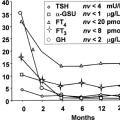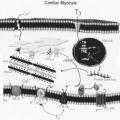Diagnosis of Thyrotoxicosis
Paul W. Ladenson
Thyrotoxicosis often presents as a distinctive clinical syndrome readily confirmed by the findings of a low serum thyrotropin thyroid-stimulating hormone (TSH) concentration and high serum thyroid hormone concentrations. Nonetheless, there are challenges in the clinical and laboratory diagnosis of the disorder. Clinically, there may be delay in appreciating that commonly encountered but nonspecific symptoms, such as nervousness or palpitations, are manifestations of thyrotoxicosis. Physicians and patients also may fail to recognize atypical and occult clinical presentations. Diagnostic testing is important to distinguish thyrotoxicosis from other conditions causing real and apparent elevations in serum thyroid hormone concentrations (1) and to differentiate among its specific causes so that the most appropriate treatment is used.
Clinical Diagnosis
The symptoms and signs of overt thyrotoxicosis often provide a virtually pathognomonic clinical picture. Diagnostic indices based on these symptoms and signs accurately identify most patients with overt thyrotoxicosis (2), but these have not been prospectively applied to primary care populations and correlate poorly with biochemical severity (3). There is considerable variability among patients in particular clinical features and their severity. For example, although weight loss despite good appetite is a classic manifestation of thyrotoxicosis, some patients gain weight and others are anorectic (4). Furthermore, elderly patients may have few or none of the usual symptoms and signs of thyrotoxicosis (4), a syndrome termed apathetic thyrotoxicosis (5), and instead present with weight loss or cardiovascular manifestations. Certain other syndromes, such as atrial fibrillation and systolic hypertension; hypercalcemia, nephrolithiasis, and osteoporosis; new or exacerbated headaches; persistent nausea and vomiting; hyperdefecation; or muscle weakness should also suggest thyrotoxicosis. Severe thyrotoxicosis may mimic febrile illnesses, heart failure due to primary cardiac disease, or toxic delirium. Thus, the clinical manifestations of thyrotoxicosis can vary considerably, and of course, the diagnosis must be suspected clinically before it can be established or excluded by biochemical studies.
In the majority of thyrotoxic patients, the cause is Graves’ disease, which may have unique clinical manifestations of its own, including urticaria, pruritus, or enlargement of the thymus or spleen. Hyperthyroid Graves’ disease is often accompanied by ophthalmopathy; rare patients have localized myxedema or thyroid acropachy (see the sections on ophthalmopathy and localized myxedema and thyroid acropachy in Chapters 18B and 18C). The presence of exophthalmos, whether symmetric or not, or other extrathyroidal signs of Graves’ disease should prompt laboratory assessment for thyrotoxicosis. Furthermore, certain groups have an increased risk for developing Graves’ disease, including women in the third through sixth decades of life, patients with a family history of autoimmune thyroid disease, and those with certain other disorders with an autoimmune pathogenesis (e.g., pernicious anemia, autoimmune diabetes mellitus, and myasthenia gravis). Patients who smoke cigarettes (6), are receiving the immunomodulatory agents interferon-α and interleukin-2 (7), or have histories of previous high-dose cervical irradiation (8) or radioiodine treatment for nodular goiter (9) are also at increased risk for developing Graves’ disease.
Clinical features also may identify patients with less common forms of thyrotoxicosis. Patients with thyrotoxicosis caused by subacute (de Quervain’s) thyroiditis typically have thyroid pain and tenderness and constitutional complaints, including fever, night sweats, and malaise. Those with toxic nodular goiter are usually older, and their thyrotoxicosis may have been provoked by recent exposure to iodine-containing radiographic contrast agents or nutritional supplements. Detection of a thyroid nodule or multinodular goiter warrants screening for overt or subclinical thyrotoxicosis. The iodine-containing antiarrhythmic agent amiodarone can also provoke either iodine-induced hyperthyroidism (even in patients without thyroid nodules) or a painless form of thyroiditis causing transient thyrotoxicosis. Silent (painless or postpartum) thyroiditis most often affects women 2 to 10 months postpartum (see Chapter 56) or after abortion or miscarriage. Less often, it can occur in women who have not been pregnant or in men. Factitious thyrotoxicosis is most likely to occur in health-care workers or persons with access to thyroid hormone preparations, for example, those with a family member or pet taking thyroid hormone, or from ingesting nutritional supplements that contain thyroid hormones.
Clues from Routine Laboratory Tests
Certain abnormalities detected in the course of routine biochemical blood testing may suggest the presence of thyrotoxicosis. These include hypercalcemia, an elevated serum alkaline phosphatase concentration, and a serum cholesterol concentration that is either low or lower than previously determined. The concentrations of certain less commonly measured substances, including ferritin, angiotensin-converting enzyme, and sex hormone binding globulin can also be increased in thyrotoxicosis. The presence of thyrotoxicosis should be considered when atrial tachyarrhythmias are detected by electrocardiography.
Table 31.1 Causes of Elevated Serum Thyroxine Concentrations | ||||||||||||||||||
|---|---|---|---|---|---|---|---|---|---|---|---|---|---|---|---|---|---|---|
|
Laboratory Testing
Biochemical confirmation of thyrotoxicosis was traditionally based on detection of elevated serum total and free thyroxine (T4) and triiodothyronine (T3) concentrations (10). Most patients have high serum concentrations of both hormones, but some have isolated increases of either T4 or T3. Although serum thyroid hormone measurements are useful for detecting thyrotoxicosis and monitoring treatment of it, they have two limitations. First, there are other causes of high serum T4 or T3 concentrations. Second, some thyrotoxic patients have serum T4 and T3 concentrations within the upper portion of the normal range. The development of sensitive assays for serum TSH has simplified the diagnostic approach for common causes of thyrotoxicosis. Their use has also expanded the spectrum of thyrotoxicosis to include mild or subclinical thyrotoxicosis (see Chapter 47), in which suppression of the serum TSH occurs despite high- or even mid-normal serum T4 and T3 levels. It is important to remember, however, that the constellation of a low serum TSH with normal thyroid hormone levels can also be due to central hypothyroidism.
Serum Thyroxine Determinations
The serum total T4 concentration can be measured accurately by competitive protein-binding assays using either anti-T4 antibodies or serum thyroid hormone-binding proteins. Most of the T4 in serum (99.97%) is bound to thyroxine-binding globulin (TBG), transthyretin (TTR, or thyroxine-binding prealbumin), or albumin. An increase in the concentration or thyroid hormone-binding of any of these serum proteins, especially TBG, can cause a high serum total T4 concentration (hyperthyroxinemia), which could be misconstrued as thyrotoxicosis (Table 31.1). Conversely, decreased T4 binding by serum proteins can mask excess thyroid hormone production.
Determining the serum free T4 concentration resolves most potential pitfalls associated with increased serum protein binding of T4. Although equilibrium dialysis and ultrafiltration are the most accurate techniques for serum free T4 measurement, serum free T4 immunoassays and the serum free T4 index readily differentiate thyrotoxicosis from the most common cause of hyperthyroxinemia, which is TBG excess. Furthermore, free T4 immunoassays and the serum free T4 index are simpler, quicker, and less costly. Most serum free T4 immunoassays employ an analogue of T4 that does not bind to thyroid hormone-binding proteins. The free T4 index is the product of the serum total T4 and the thyroid hormone-binding ratio (THBR; also known as the T3 or T4 uptake) (11). These assays are discussed in detail in Chapter 13.
Other conditions that cause euthyroid hyperthyroxinemia can be more difficult to differentiate from thyrotoxicosis. Patients with familial dysalbuminemic hyperthyroxinemia have a mutated form of albumin that binds T4 with increased affinity, increasing the serum total serum T4 concentration (12,13). Serum free T4 analogue immunoassay methods also may yield falsely elevated values in this condition. Because the mutated albumin usually binds T3 poorly, the THBR value, which uses radiolabeled T3 in vitro, is typically normal, and, therefore, the calculated free T4 index value is deceptively high. Similarly, increased TTR binding of T4, which can occur as either an inherited trait (14) or a paraneoplastic phenomenon in patients with carcinoma of the pancreas or liver (15) can cause an increased serum total T4 concentration. Endogenous thyroid hormone-binding antibodies, which may be present in patients with chronic autoimmune thyroiditis or other autoimmune disorders, can cause spurious elevations of the measured serum T4 or T3 concentration (16).
Hyperthyroxinemia also may occur as a result of disorders that transiently increase the secretion of TSH (or chorionic gonadotropin). It can accompany systemic nonthyroidal disorders and medications that reduce T4 clearance by deiodination. For example, in one study of patients admitted to an inpatient medical service, modest elevations in serum total T4 and free T4 index values were found in 4% and 12%, respectively (17). Two disorders—acute psychosis (18,19) and hyperemesis gravidarum (20)—have been associated with substantial prevalences of euthyroid hyperthyroxinemia. Propranolol, when given in high dosages [>160 mg/day (21)], and amiodarone (22) can impair T4 clearance, causing euthyroid hyperthyroxinemia (see section on Effects of Pharmacologic Agents on Thyroid Hormone Metabolism in Chapter 11). Even though they have no clinical evidence of thyrotoxicosis, some patients receiving T4 therapy have modest hyperthyroxinemia. Finally, patients with generalized thyroid hormone resistance typically have elevated serum total and free T4 and T3 concentrations with normal or slightly increased TSH concentrations (23) (see Chapter 58).
Stay updated, free articles. Join our Telegram channel

Full access? Get Clinical Tree








